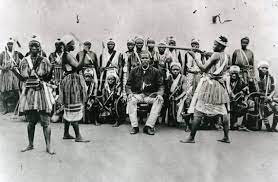Historical accounts of African warfare and warriors are often regarded as folk tales many times, but are they? In the current society, the warrior ethos has been romanticized on many cinema fronts, and it continues to linger. Various campaigns use the warrior moniker to express fierceness. But the stories aren’t folk tales, they represent actual personalities that altered the continent’s history.
Well without such organized armies, the African continent would have easily been conquered by white colonialists or invaders at the time, such protective armies did not only protect their kingdoms from white colonialists but also from their neighboring communities that attempted to invade them.
Who are the greatest African warriors celebrated by different societies and nations? Well, today we look at the Dahomey Amazons one of the most formidable female armed forces that Africa has ever had.

There are different types of African warriors, and the Dahomey Amazons create a unique group. They were female African warriors who were known to be ferocious fighters and had a reputation for decapitating soldiers during battle.
They represented the Kingdom of Dahomey, which is nowadays’ Republic of Benin. The female warriors fought alongside male soldiers in 1890 in the First Franco-Dahomeyan War against the French. Their impressive skills and remarkable agility allowed the warriors to overwhelm the French troops.
At its peak, the women warrior troops were organized into different regiments, dedicated to performing specific and designated tasks. These included the Gbeto (Huntresses) women who were skilled at hunting and killing elephants and other game. This regiment is thought by some to have been the original all-women warrior unit in Dahomey. The Gulohento (Riflewomen) was the largest regiment. In addition to rifles, the women in this group might have also carried short sharp swords or spears.
A much smaller regiment was the Nyekplohento (Reapers). The women in this group carried sharp knives and had a reputation for being fierce and ruthless, and they were possibly the regiment that was most feared by Dahomey’s enemies. There was also the Gohento (Archers) was also a smaller regiment and comprised excellent markswomen, who used bows and poisoned arrows.
By one account, their role diminished with the proliferation of firearms, and they transitioned into serving as noncombat support to the other regiments. The women in the Agbalya (Gunners) regiment used large—and loud—artillery weapons, useful for intimidating their enemies in battle. Each regiment had its own uniform, symbols, and rituals.
The warrior women fought with distinction in many of Dahomey’s battles with neighboring kingdoms and, later, against French colonial forces. The first battle they are thought to have participated in was that at Savi in 1727. They fought in several conflicts in the 19th century, including the kingdom’s two wars against the French, in 1890 and 1892. It was after the last battle in November 1892 that the Dahomey kingdom fell, and the women warrior corps disbanded.
The Dahomey women warriors have served as inspiration for storytelling in books, movies, and motion pictures. They are reportedly the inspiration for the elite female bodyguards and warriors known as the Dora Milaje in Marvel’s Black Panther comics and movies. The fictionalized account of a Dahomey warrior general, played by Viola Davis was the focus of the 2022 film The Woman King.
Kamukama Rukundo Clinton is a Ugandan pan-Africanist, author, and columnist for 1cananews who can be contacted via +256704393540 or rukundopeter33@gmail.com















































